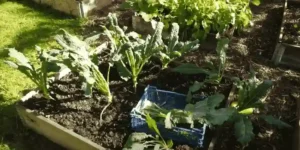Have you ever wondered how to make the most of collard greens in your garden and kitchen?
These leafy greens are not just for Southern comfort food, they’re versatile and packed with nutrients.
Whether you’re new to gardening or a seasoned pro, understanding how to grow, cut, and cook collard greens can elevate your meals and your garden.
Let’s dive into some practical tips and benefits that will help you make the most of this amazing green!
Hi, I’m Hasan, and I’ve been gardening for about 8 years. Today, I’m sharing everything you need to know about collard greens.
Table of Contents
Quick Guide to Growing Collards

Plant collard greens in the spring, about 3 to 4 weeks before the last frost.
They thrive in raised beds, containers, and in-ground gardens.
Make sure to space them 18 to 24 inches apart in an area with full sun and well-drained soil with a pH of 6.5 to 6.8.
Improve your soil by mixing in compost or other rich organic matter.
Keep the soil moist and feed your collards regularly with water-soluble plant food.
Mulch with organic material to keep the soil moist and prevent weeds.
Harvest the young leaves when they are dark green and about 10 inches long.
How to Cut Collard Greens
Cutting collard greens is easy and quick. Start by cleaning the leaves in water to remove any grit.
Fold the leaves in half lengthwise and cut off the stems and thick ribs.
Stack the halved leaves and slice them to your desired size.
Now they are ready for salads, soups, or to be sautéed.
How to Eat Collard Greens

Collard greens are versatile in the kitchen. Use them as a wrap for sandwiches instead of tortillas.
Slice them into ribbons and sauté with onion, garlic, and apple cider vinegar. Add them to stir-fries, soups, or chili.
Stuff them like cabbage leaves or blend them into smoothies.
Cooking Tip: Don’t throw away the brothy water leftover from cooking greens, known as “pot liquor.”
This nutrient-rich liquid can be used as a soup base or in sauces.
Health Benefits of Collard Greens
Collard greens are packed with nutrients:
- 11% Copper
- 11% Vitamin E
- 17% Choline
- 30% Fiber
- 80% Vitamin A
- 49% Manganese
- 858% Vitamin K
- 15% Vitamin B2
- 46% Vitamin C
- 12% Iron
They help lower cancer risk, support heart health, and provide essential vitamins and minerals.
What’s In Season?
Collard greens are a cool-weather crop, best grown in fall and spring.
They are rich in Vitamin K and Iron, which support healthy blood, and Vitamin C, which boosts the immune system.
Types of Greens
Explore other greens like Romaine, Swiss Chard, Spinach, Iceberg, Red Leaf, Kale, Arugula, and Butter Lettuce. Each has its unique taste and nutritional benefits.
How Long to Cook Collard Greens
Here’s a simple recipe for cooking collard greens:
Ingredients:
- 2 lbs. collard greens (3 bundles)
- 1 pre-cooked/smoked turkey leg (optional)
- 1 cup diced yellow onion
- 2 cups diced tomatoes
- 4 cups chicken stock (or vegetable stock)
- 1 tbsp. apple cider vinegar
- 3 tbsp. Worcestershire sauce
- 2 tbsp. honey
- 1 tbsp. hot sauce or sriracha
- 2 cloves minced garlic
- 1½ tsp. Old Bay seasoning (or Cajun/Creole seasoning)
- 1 tsp. red pepper flakes
- 1 tbsp. salt
- 1 tsp. black pepper
Cook everything together for a delicious and nutritious dish.
Collard Greens Nutrition Facts
Collard greens are a great source of vitamins C and K and soluble fiber.
They contain glutathione, which helps the liver detoxify fat, boosts immune function, fights cancer, and protects the body from toxins.
- Serving Size: 1 cup cooked (49 kcal)
- Protein: 4g
- Fat: 1g
- Carbs: 9g
- Fiber: 5g
- Sodium: 30mg
- Vitamin K: 836mg (1,045% DV)
- Vitamin A: 15,416 IU (308% DV)
- Vitamin C: 35mg (58% DV)
Common Pests and Diseases: Collards
Watch out for aphids and imported cabbage worms.
Aphids cluster on the back sides of leaves, and imported cabbage worms eat through the leaves.
Spray aphids off with a hose and handpick the caterpillars.
For diseases, rotate crops to prevent the build-up of pathogens.
Beta Carotene-Rich Foods
Collard greens are rich in beta carotene, along with pumpkin, winter squash, sweet potatoes, carrots, greens (kale, collards, spinach, chard, turnip greens, beet greens), orange bell peppers, and broccoli.
Conclusion
Collard greens are a fantastic choice for any garden. They’re easy to grow and offer a nutritious punch.
Start by planting them in a sunny spot with well-drained soil. Water regularly and keep an eye out for pests.
Once your collards are ready, cut the leaves by snipping them off at the base.
They’re versatile in the kitchen, sauté, steam, or add them to soups.
Their health benefits are impressive, packed with vitamins A, C, and K, plus calcium and fiber.
To wrap it up, collard greens are a practical, healthy addition to your garden and kitchen.
Their ease of growth and multiple uses make them a winner for any gardener looking to add a nutritious green to their diet.
If you have any questions or want to share your tips, feel free to reach out.
| Winter Season Vegetables |
| Beets Benefits, Growing Tips, and More |
| Avocados: A Comprehensive Guide to 8 Varieties, Benefits, and Tips |
| Broccoli Benefits, Nutrition, Tips and more |
| Spring Season Vegetables |
| A Simple Guide to Artichokes- From Picking to Cooking |
| Kale: How to Grow and Tips from an 8-Year Gardener |
| Leeks- Easy Growing Tips from Seed to Harvest and Recipe |
| Summer Season Vegetables |
| The Complete Guide to Growing and Using Cucumbers |
| How to Grow Corn and Its Many Benefits |
| From Seed to Harvest: A Beginner’s Guide to Growing Okra |
| All About Eggplant- Growing Tips, Pests, and Delicious Recipes |







